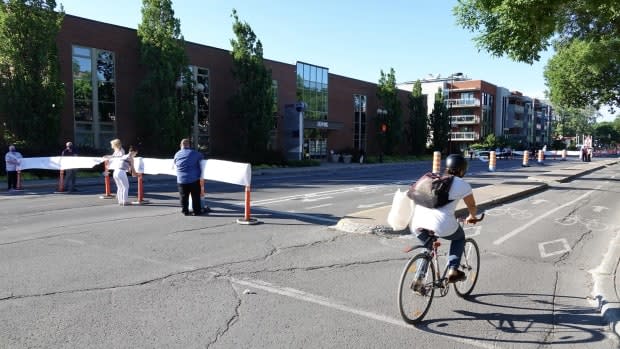Montreal roads got a facelift last summer. The result was confusing and sometimes dangerous, report says
The city of Montreal's temporary pedestrian and cyclist corridors implemented earlier this year were meant to make it easier for people to get around and physically distance, during the first wave of the COVID-19 pandemic.
In many cases, however, the new installations made it more difficult for people to get on and off buses, and created confusion as well as road safety hazards, according to a report by the city's ombudsman.
Part of the confusion was caused by unclear signage, which made it difficult in some cases to know if the corridors were intended for pedestrians or cyclists, the report said.
Between May and October, the ombudsman's office received more than 300 complaints regarding the corridors as well as the construction of various bike paths, including those included in the city's highly-touted Réseau express vélo (REV).
"This amalgamation of work created a great deal of confusion among Montrealers," said Nadine Mailloux, who took over as the city's Ombudsman in August.
Mailloux highlighted that complaints came from a wide variety of people, including seniors, people with mobility issues, and cyclists.
It is not part of Mailloux's mandate to comment on whether or not the city's decisions were the right ones, but she did offer 15 recommendations to improve safety, communication with residents and universal accessibility for future bike path projects and in the event that similar corridors are re-installed in the future.
The report highlights that many complaints were related to the loss of parking space as a result of the corridors installation, but the ombudsman focused on the issue of universal accessibility, and mainly looked at what happened to spots that were reserved for people with mobility issues.
"Our investigation revealed that certain [parking] spaces were sometimes, following their removal, not put back or put in within an appropriate distance," the report stated, while urging the city to consider all of the potential consequences of its plans.

Using Rachel Street and Christophe-Colomb Avenue as examples, the ombudsman pointed to the challenges city buses faced, often having to pick up and drop off passengers right on the edge of a pedestrian or cyclist corridor, forcing the bus to come to a stop while occupying at least part of another traffic lane.
The corridors also put car drivers and their passengers in a tough spot, according to the report.
In some cases, the ombudsman found that people exiting vehicles to the left would find themselves in the middle of traffic, and those exiting to the right would sometimes find themselves dodging oncoming cyclists.
The ombudsman also found that in some cases, the city provided little advance warning and too few details regarding the work that was going to be done to put in the corridors, as well as the loss of parking space that would follow.
In a statement, Montreal Mayor Valérie Plante acknowledged the city "has work to do to improve communications with citizens." Plante also said the pedestrian and cyclist corridors were deployed quickly due to the pandemic, and adjustments were made throughout the summer.

